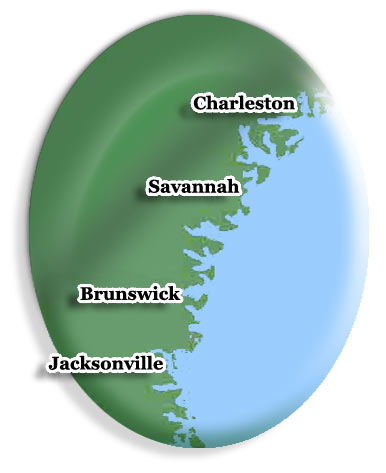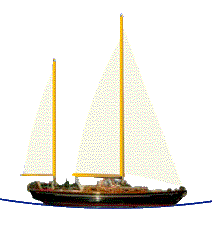



CLICK ON UNDERLINED BLUE TEXT FOR PHOTOS
Ships Log November 26-29, 2005 Miles 463-576 Offshore to Savannah, GA
Tides and the choice of Coastal or ICW travel routing -The southern South Carolina and Georgia ICW has many very shallow stretches. It is possible to travel the ICW with a draft of 6'3", but you must do so when the tide is high and rising. Georgia has a 9 foot tide so timing makes all the difference. Conditions for ICW travel are best with a midday or midafternoon flood. The silted shallows are covered and if you do get hard grounded, the rising tide will lift you off. If the conditions give you a midday ebb, then you travel short distances in the late afternoon before dark, or take the outside route. Since the ebb was at midday, we made outside jumps.
We left Charleston on the falling tide and made good time out into the Atlantic. Our destination was the Edisto River, a short day's sail south. The route took us five miles off the coast. There was a large swell and 5 foot waves, but the 15 knot NNE wind filled the sails and made the ride pleasant. Mid morning, we saw the biggest sea turtle we had ever encountered. It's thick, horned shell was 5 to 6 feet in diameter and its head was nearly the size of a basketball. We were reminded of a dinosaur.
When we travel beyond the local waterways, away from the coast and in the Atlantic, we wear a PFD (personal floatation device) and harness clipped into a secure eyebolt when in the cockpit, and clipped to a jackline when on deck. Since often only one of us is on watch at a time, this increases our confidence in our safety.
Our trip up the Edisto River was with the rising tide and we again made excellent time. The Harbormaster of the Edisto Marina was at the Christmas Parade, so we tied to an empty spot on the dock and settled in for the night. At first light, we sailed with the ebb back out into the Atlantic and again traveled about 5 miles offshore. The sea state was similar to the day before, but the morning wind was under 10 knots. The swell was off the stern quarter and made for a very roly-poly uncomfortable morning. Fortunately, the wind increased by noon and its pressure in the sails controlled the roll.
Many porpoises passed the boat, but few joined in our bow wave. As we entered the Savannah River, we were struck with a deluge that reduced visibility to one foot! At least it washed off all the salt. The storm cleared to reveal petroleum tanks, refineries, chemical plants and a foaming pollution slick on the river. The banks on both sides of the river were lined with hazardous waste burial sites. Unlike all the other rivers we had traveled, there were no porpoises here.
We arrived at downtown Savannah and tied up to the municipal dock . The waterfront is lined with former cotton warehouses converted to restaurants. The riverfront street is paved with cobblestones that had been ballast on the sailing ships that picked up the cotton at the wharves. We climbed the old waterfront stairs , and entered the heart of the town. Downtown Savannah is laced with charming small parks .
The climate here seems much warmer than even Charleston a few miles to the north. The air is humid and tropical plants grow everywhere. The live oaks trees are thickly draped with Spanish Moss. The streets are quiet and traffic of cars, trucks and trolley cars slowly winds around the parks. James Edward Oglethorpe founded Georgia in 1733. His name is found everywhere in town; in Oglethorpe Park, Square, Avenue, etc. In the name of King George of England, he negotiated a settlement treaty with Tomo-Chi-Chi, Mico of the Yamacraws. Tomo-Chi-Chi, was a great friend of the English and is still considered the co-founder of Georgia. With his wife Senauki, he traveled to England in 1735 and was received by the King and the Archbishop of Canterbury.
The side streets of Savannah are beautiful and lined with flowers and tropical plantings. The buildings (photo 1, #2, #3, ) are of an interesting and varied architecture. James Moore Wayne, former mayor of Savannah, was Associate Justice on the US Supreme Court from 1835 to 1867. He continued to serve on the Court even when Georgia seceded from the Union. He lived in the Gordon House a fine example of Regency architecture. In 1860, Juliette Low was born in this house. She became the founder of the Girl Scouts of America. Our favorite coffeehouse, the Gallery Espresso provided us with terrific lattes and a WiFi connection to send our Ships Logs using our business laptops. Our favorite restaurant was the jungle shrouded Belfords. Around the corner, we found the offices of Phillip Marlow, Private Eye.
Although there is no snow, the Xmas season is in full swing here. Just before dusk, the 100+ foot American Glory came to the city dock. Luckily we were aboard and could move Raven to the very end of the dock to make room. With bow thrusters roaring, the giant tour cruise boat slipped through the quick current and within feet of Raven. In the morning, we awoke to a think fog mixed with high sulfur dioxide concentration from the nearby paper mills. Savannah is a lovely town surrounded by industrial contamination.
v